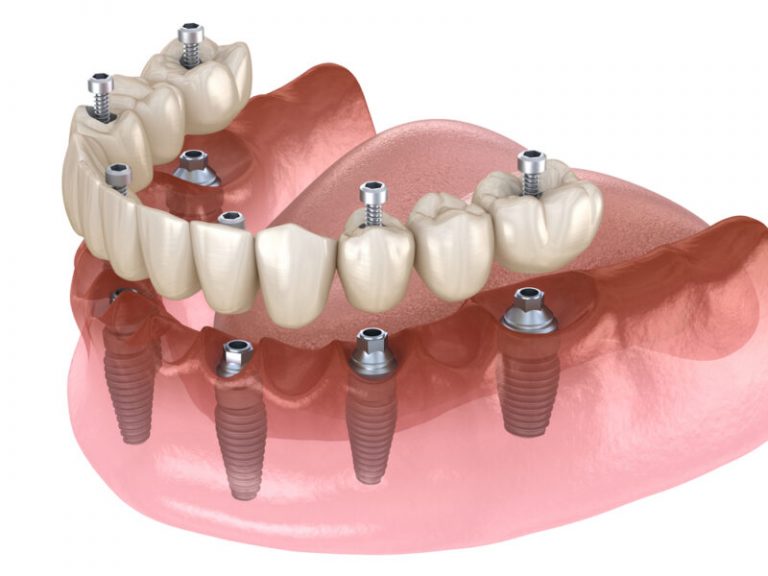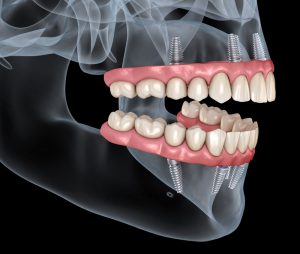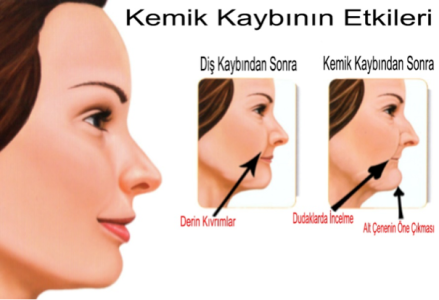

Implant is the surgical dental application that a person needs if he loses his natural teeth for certain reasons after many factors throughout his life. The implant is as strong as natural teeth without affecting the person's quality of life. A new tooth is placed in the cavity of the extracted tooth or previously lost tooth with implant treatment. These teeth, which are then implanted, are surgically mounted, just like real teeth attached to the tooth root and jawbone.
Implant teeth can fulfill the comfort, aesthetics and vital functions of lost teeth and give a real tooth feeling. Thanks to the titanium alloy material from which the implant is made, it biologically adapts to the human body and can imitate real teeth.
The patient who is planned to be implanted;
First, a panoramic x-ray is taken from our patient and the bone level is seen. The surrounding tissues, adjacent spaces, nerves and vessels are determined in the area where we will implant. If necessary, a deeper examination is made with dental tomography.
If there is no special situation, implant surgery is performed under local anesthesia. After anesthesia, the gingiva is opened and the bone is reached. With special drilling burs, cavities are opened in the jawbone of the size and diameter where we will place the implants. Implants are screwed into these spaces. Spacers are attached to the implants. Measurements are taken and prostheses are made. we will have to come back 2-3 months after the implant and wear the crowns.
Why Implant?
At the current stage of dentistry, the best dental treatment option that can replace the natural tooth in cases of tooth deficiency is undisputed dental implants. Teeth do not need to be cut to make teeth or bridges. Dental tissues are protected at the maximum level by performing implant treatments.
Eliminates Chewing and Digestion Problems
Patients using prostheses have great difficulty, especially when eating, and have difficulty in chewing. The implant eliminates chewing problems. The chewing function in the mouth is provided in the best way.
Implant Prevents Bone Loss.
In case of tooth extraction or loss for any reason, bone is not needed to hold the teeth; bone enters the process of melting and destruction. The implant prevents the jawbone from melting and shrinking.
Especially in cases where a total denture is used due to the loss of teeth in the lower jaw, with the melting of the bone supporting the prosthesis over time, the retention of the prosthesis decreases and the expected benefit from the prosthesis decreases.
In short, the implant holds the jawbone together, prevents osteoporosis and delays aging.
Implant Allows Tasting
In the case of using prosthesis due to the loss of teeth in the upper jaw, people cannot taste as much as the prosthesis covers the palate, and the prosthesis also creates a problem of nausea. The implant eliminates such problems.
Implant Teeth Provide Psychological Support
Especially in the case of using a total prosthesis, the retention of the prosthesis decreases due to bone resorption with advancing age. Patients have difficulty in using their prosthetic (denture) teeth. He is disturbed by the sound of the prostheses while eating and talking, and he feels old. On the other hand, since implant-supported dentures do not move and are the closest solution to natural teeth, they fully fulfill their eating, drinking, speaking and aesthetic functions. This provides psychological support to patients.
Implant Teeth
Implant Provides Psychological Support
Implant is Aesthetic
Implant teeth contribute to the self-confidence of the individual with their natural and aesthetic appearance.
Implant is a long-lasting and effective dental treatment option.
Implant treatments prevent you from experiencing the problem of bad breath that occurs from time to time in alternative treatment methods.

All on 4 and All on 6 Techniques
All on 4 and All on 6 implant application techniques; It is the process of fixing the dental prosthesis with minimum implant application for patients who have compatibility problems in removable prostheses due to bone loss, who want to have fixed prosthesis, and who have lost all their teeth. In these procedures, 4 to 8 implants are applied depending on the condition of the jaw bones of the individual. You can find more detailed information about implant applications in our Dental Implant article. All on 4 and All on 6 applications increase the comfort of use by fixing the prosthesis. In addition, it provides an aesthetic advantage as temporary prostheses can be applied to the patient on the day of the procedure.
Who are the All on 4 and All on 6 techniques suitable for?
All On Four and All on 6 treatment techniques; It is a suitable procedure for patients who have lost all their teeth and do not have any health problems that may hinder implant applications. In addition, All On Four and All on 6 techniques; It is also a suitable option for implant treatment in the same session with the extraction of these teeth in patients whose teeth are too damaged to be treated or who have lost their surrounding bone support. Multiple implant applications may not be preferred by these patients, or additional treatments may be required for implant application in the missing areas due to significant bone loss, especially in the posterior regions of the jaw line. In these cases, All on 4 and All on 6 techniques are suitable treatment alternatives for fixed prosthesis without the need for additional procedures.
What are the advantages of the All on 4 and All on 6 techniques?
The fact that All on 4 and All on 6 applications allow prosthesis to be made on the same day as implant treatment in patients who have lost all their teeth provides a great advantage in restoring aesthetic and functional properties. The aesthetics of the prosthesis can be easily planned individually. Arranging the smile line and providing smile aesthetics can also be included in this planning. In the application of All on 4 and All on 6 treatment techniques, there is no need for additional procedures to increase the amount of bone mostly on the jawbone or at the base of the sinus. It is a comfortable treatment option. There is usually no pain or edema after the procedure. Rarely, there may be minimal pain and edema. However; With the regular use of the drugs prescribed by the dentist, loss of comfort in this process can be easily prevented. Cleaning and maintenance of dentures made with All on 4 and All on 6 techniques is easier than standard dental implant applications. Thanks to the fact that the prosthesis prepared in the application is fixed and there is no part that fits on the palate area, it is much easier to use than removable dental prostheses.

What awaits you in the All on 4 and All on 6 treatment processes?
In order to plan All on 4 and All on 6 treatments, the first session of clinical and radiographic examinations should be done in detail. It should be checked whether the gingival tissue and the amount of bone are sufficient for implant placement. In cases where it is not sufficient, additional procedures can be applied before the treatment to gain the needed tissue in the relevant area. Depending on the condition of the tissues, bone addition is done by adding bone powder or by taking the patient's own bone from a different region and placing it in the area where it is needed. If these procedures are performed by specialist surgeons, it is necessary to wait 4-6 months for the bone to reach the ideal quality. After this process has passed, implant application can be made by providing the necessary controls.
If all conditions are suitable for the application, an impression is taken to prepare the temporary prosthesis. Computed tomography, which allows a detailed examination of the jawbones, is used to determine the most ideal treatment that can be done while preserving the health of the surrounding tissues. Detailed measurements are made on the patient's tomography image, and the areas where the implants will be applied are determined. In line with the plan created, if there are teeth that need to be extracted on the treatment day, 4 or 6 implants are applied. These transactions are; It can be easily performed under local anesthesia, but it can also be performed with sedation or general anesthesia in patients with high levels of anxiety and fear. Temporary dental prostheses are fixed on the implants on the same day as the implant applications. The fusion process of the implant and the bone is passed comfortably with temporary prostheses. At the end of this process, which takes an average of 3 months, the implants are ready for permanent prosthesis.
What kind of process awaits you after the All on 4 and All on 6 processes?
Pain or edema rarely occurs after All on 4 and All on 6 procedures. This situation can be easily overcome without loss of comfort. Regular use of the drugs prescribed by the dentist and cold compresses on the area are sufficient to control pain and edema in a short time. After the application, patients should be careful to put as little load on the temporary dental prosthesis as possible. For this, foods with hard or sticky forms should be avoided, and soft foods should be preferred during the process of temporary prostheses in the mouth. When the bond between the bone and the implant is ideal, the transition to permanent dental prostheses is made. When the permanent dental prosthesis is fixed on the implant, it is possible to return to the normal diet. Attention to oral care is also an important factor for the life of implants.
What are the factors that determine the lifetime of All on 4 and All on 6 applications?
All on 4 and All on 6 applications, whose long-term success has been proven by researches, are the most comfortable methods for patients for whom this treatment technique is suitable. However, in this process, it is of great importance to ensure a good connection between the bone and the implant. In order to create this connection in the most ideal way, the patient's medications and recommended diet; It should be applied as recommended in the required period. And also; During the period when both temporary and permanent dentures are used, attention should be paid to daily oral care and regular physician checks should be made. In this way, the possibility of infection around the implant and the loss of the implants are prevented.
TOOTH EXTRACTION, BONE REMOVAL AND IMPLANT
The human body works on the principle of "using an organ, losing it if not using it". An example of this is the development of muscles when doing sports regularly, and the shrinkage of arm or leg muscles that cannot be used in cases such as paralysis. The human bone in general, and the jawbone in particular, work on the same principle. The presence of teeth or dental implants and the application of force to the bone during biting strengthen the jawbone and hold it together. In case of tooth extraction, bone is not needed to hold the teeth. Therefore, the bone enters the process of melting and destruction. A condition called osteoporosis occurs. In this respect, implantation instead of extracted teeth prevents the melting and shrinking of the jawbone. Although the rate of bone loss is not the same in all individuals, bone destruction is inevitable in everyone who loses their teeth.

CAUSES OF JAW BONE REMOVAL
In addition to tooth extraction, infection, formation of cysts and tumors in the tooth root, gingival diseases, bruxism, teeth clenching and grinding habits, incorrectly made fillings, incorrectly made fixed and removable dentures, dentures that have expired, and accidents can also cause bone loss/bone resorption. .

Even if other prosthetic dental treatments, except for implant-based prostheses, are done very well, bone loss (bone resorption) will be inevitable, since there will not be a structure that holds the bone.
OTHER NEGATIVE CONSEQUENCES OF JAW REMOVAL
1- Exposure of nerves and inability to use prosthesis
In excessive bone loss, the lower jaw becomes very thin. There is a nerve that passes through the lower jawbone and comes out of the bone at the level of the roots of the premolars. When the patient's use of the removable prosthesis puts pressure on this nerve, the patient feels pain like a needle stick and cannot use the removable prosthesis.
2-Aesthetic Problems

In case of loss of teeth and jawbone; The facial image appears shortened and the tip of the lower jaw approaches the nose. When viewed from the profile, an image appears as if the lower jaw is ahead of the upper jaw. Due to the loss of jawbone, facial muscles, chewing muscles and lip muscles are deformed, cheek and lip support are lost. In addition to a significant loss in lower face height, a sagging and wrinkled appearance appears on the upper face. Therefore, bone loss is an important factor in looking old.

3-Increased Treatment Cost (Price) or Impossibility of Treatment, Loss of Function
The anatomy of the jawbone is very important in implant dental treatment. In order to make a standard dental implant, the bone should be at least 5-6 mm thick and 10-12 mm high. The small size of the jaw structure and bone and the passage of the nerve in the lower jaw sometimes make it difficult to implant. Sometimes it makes it impossible. If the jaw bone melts as a result of not implanting on time, it makes the implant construction even more difficult in the future, in such cases removable prostheses with implant retention can be used. The upper jaw is close to the maxillary sinus. Enlargement of the sinuses and/or drooping of the extracted tooth make implant placement difficult. In some cases, sinus lift operation is required before the dental implant is placed. In some cases where the bone is insufficient, a second operation, such as a bone transplant from other parts of the body, or a bone graft may be the solution. However, these alternatives not only make treatment difficult, but also increase the total implant treatment price. In fact, in some cases, excessive bone loss may make implant construction impossible.
WHEN SHOULD THE IMPLANT BE DONE IF THE TEETH IS EXTRACTED?
As stated above, implant treatment by the dentist without delay (ideally 2-3 months) in case of extraction or loss of natural teeth; It is very important in terms of preventing bone loss, not causing loss of function, not causing aesthetic problems and premature aging, and reducing the cost of the procedure and therefore the total treatment price.
SINUS LIFTING
Sinus lift is a technical term meaning sinus lift. It is no longer discussed that the implant is the best treatment option for missing teeth. However, for a successful implant treatment, there must be sufficient bone in quality and quantity to support the implant. Therefore, in some cases, bone augmentation and additional surgical procedures are required in cases where the bone structure is insufficient in the area to be implanted. One of the treatment options that comes to the fore in such cases is sinus lifting operation.
Why sinus lift
In different parts of the skull bones, there are air spaces called the frontal sinus, ethmoid sinus, siphonous sinus and maxilla sinus.
A pair of cavities with a volume of about 15-20 cc above the roots of the premolars and molars, on the right and left in the upper jaw, is called the maxillary sinus. The maxillary sinus is directly related to dentistry and especially implant applications due to its anatomical location and structure.
After the extraction of small and large molars, bone resorption becomes inevitable. Accordingly, air pressure causes the maxillary sinus cavity to expand in volume and tends to sag downwards with the effect of tooth loss and gravity. As a result, there is a decrease in bone height and there is not enough bone height to be implanted in the area.
Therefore, in order to be able to implant in this area, sinus linfting (sinus floor lifting) should be performed in order to reduce the volume of the sinus and increase the bone volume, and the resulting cavity should be filled with bone powder.
How to Perform Sinus Lifting
The basis of the sinus lifting operation is to open the bone from a small area in the molar and premolar region, to lift the sinus membrane, and to fill the space where the implant will be placed later with bone grafts and / or bone transplanted from other parts of the body, if the amount of bone is partially sufficient, by applying the implant in that session. If the amount of bone is not sufficient, it is closed without implant application.
In this way, by increasing the vertical bone size in the region; the area is made suitable for implant applications.
In cases that are closed without implant application, bone formation is completed after three to six months and then implant application is started.
Sinus lifting operation can be performed in any dental clinic under local anesthesia.
However, the maxilla can be in very different anatomical structures; In addition, in individuals who remain edentulous for a long time, the sinus mucosa may enlarge in volume, become thinner and easily tearable. Therefore, sinus lift operation and grafting are important.
Depending on the concrete case, different sinus elevation techniques can be used by the dentist or specialist dentist.
Surgical procedures performed by Ear Nose and Throat Specialists and referred to as sinus surgery or sinusitis surgery are related to the ENT branch and are completely different surgical procedures from sinus lifting operation.